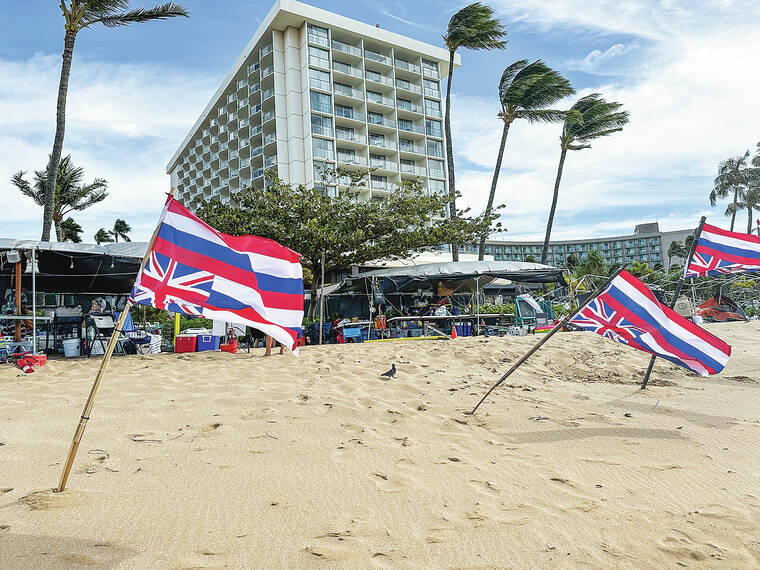Hawaii hotel bookings dip as travel demand weakens
Buckle up — the path to recovery for Hawaii’s visitor industry is getting rockier as it heads into 2024.
A decrease in demand since the Aug. 8 Maui wildfires has exacerbated prior softening in the market and has resulted in fewer hotel room nights on the books for next year. Airlines also have pulled some seats out of some markets, which can speed dampening in a destination like Hawaii that relies on air and cruise traffic.
ADVERTISING
A Hawaii Hotel Performance Report published Monday by the Hawaii Tourism Authority belies current conditions, partly because West Maui is filled with displaced residents as well as disaster and construction workers, and also because tourism performance is growing more dynamic.
That report, compiled using data from STR, showed statewide occupancy in October hit 74.5%, a 2.3-percentage-point increase from October 2022. The average daily rate for hotel rooms statewide was up 2% to $347, and the revenue per available room rose 5.2% to $258. Hotel room revenues statewide reached $447.8 million, a gain of 5.7% from October 2022.
Even Maui’s hotel occupancy in October was a little better than at the same time in 2022. However, fire-related impacts, especially in West Maui, contributed to a year-over-year drop in the average daily rate, revenue per available room and overall revenue.
October occupancy at Maui hotels was 66.5%, a 0.5-percentage-point increase from October 2022. The average daily rate at Maui hotels in October was $506, down 3.2% from October 2022. Maui’s revenue per available room fell 2.5% to $336, which led the rest of the counties.
“It really shows what we had, but the report doesn’t show were we are going,” Jeffrey Eslinger, senior director, market insights, Hawaii Visitors &Convention Bureau, told the Honolulu Star-Advertiser on Monday.
Total room nights on the books statewide as of Nov. 5 compared with the same time in 2022 were up 3.9% in November, down 3.3% in December, up 0.5% in January, down 5.6% in February and then flat to down all the way to October, which was off 26.8%, according to HVCB’s analysis of TravelClick Data.
Maui room nights on the books as of Nov. 5 were up 1.6% in November and down 3.6% for December and 1.4% in January but were off 26.1% for February and as much as 46.8% for October.
While hotel bookings are dynamic, Eslinger said, “What we are seeing on the books is not enough to offset all the losses we had on Maui from a statewide transient accommodations tax (TAT) perspective.”
HVCB’s analysis of Diio Mi data shows that the number of scheduled nonstop air seats statewide from Hawaii’s top U.S. source market in October was up 1% but down 3.2% in November and 8.1% in December.
HVCB’s U.S. trans-Pacific air seat synopsis for January to June 2024 is projected to be down 4.7% statewide. Oahu is projected to get a 1.5% gain in air seats from the U.S. for that period. However, a 16% drop is projected for Maui, with a 3.6% decline expected in Kona, a 100% decrease in Hilo and a 7.4% decrease on Kauai.
Eslinger said some of the challenges on Maui are related to service adjustments to Kahului since the wildfires. He said 87 flights and 15, 672 seats have been lost through Nov. 18.
“I think that we were already seeing softness and reduction from 2022 into 2023 for Maui as well as direct service to the neighbor islands from the North American continent for the fall and late summer even before the fires,” Eslinger said. “That has amplified now for Maui, and somewhat for the neighbor islands especially into the first quarter of 2024.”
He said nonstop air seats from the U.S. to Oahu are forecast as flat to positive from January to April, but the neighbor islands are seeing declines.
“The sad thing is that spring break (and Easter are) in March this year, and we are still going to see a 24% decrease in nonstop seats to Maui. But we also are seeing (decreases) to Kona and Kauai as well,” he said.
Eslinger said a challenge for airlines is that travel booking windows to Hawaii have shortened, sometimes to less than 30 days out. He said another difficulty for airlines is that since COVID-19 many travelers have been booking hotels and rental cars first.
Eslinger said the Maui wildfires also continue to have a broad effect on overarching traveler sentiments. He said people who are not tried-and-true travelers to Hawaii might look elsewhere for the time being.


